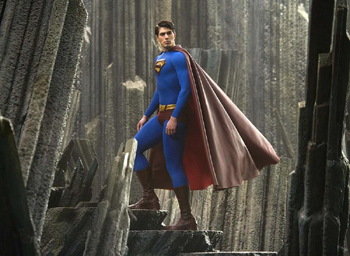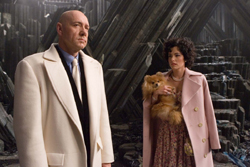Making movies. Enjoying movies. Remembering movies.
THE SCREENING ROOM
Related Articles:
More Articles by Rick
Mitchell
|
By Rick Mitchell

As a kid, I read and collected super-hero comics. I was raised on the DC line, "Superman", "Batman", etc. I stopped reading them about the time that Marvel became prominent, so I was never into that line.
I haven't been a fan of most of the film adaptations of comic books in recent years. To me they all have the same flaw, spending half the film trying to prove the super hero is a normal person with human problems like everyone else, then pitting them against a villain that's so far over the top as negate all that's gone before. The problem lies with the parties in creative control, either taking the films too seriously and going too heavily for "warmth and charmth" as Samuel Goldwyn would put it, or not taking them seriously enough, treating them as camp.
 |
It's a very thin line filmmakers walk to get the right combination that makes such films work not only for comic book fans, especially fans of the particular super-hero, but the general public as well. It's now conceded than Richard Donner came closest with "Superman" (1978); the only other super-hero films I liked were "The Phantom" (1996), on which director Simon Wincer carried on with the approach planned by original director Joe Dante, and last year's "Fantastic Four."
Which brings us to the much anticipated "Superman Returns." This film appears to have been approached as a sequel to the Donner film, ignoring its three sequels. The idea is that some time after the film ended, astronomers discovered what could be the remains of Krypton and Superman took a five year sabbatical to investigate. When he returns, he finds a number of changes that affect his personal life, yet on the whole, the result is essentially a remake of the Donner film. Not only is John Williams' theme, as well as other cues, used, but the opening credits are done in exactly the same way as those of the earlier film. Though not frame-for-frame copies, practically every sequence in the film echoes one in the earlier film. The writers even acknowledge this by reusing certain lines from the first film.
Brandon Routh, the new Superman, seems to have based his performance on that of the late Christopher Reeve, and in his Clark Kent persona, is almost a dead ringer for Reeve. (But then one shudders at what Nicolas Cage would have done to the part!) Worse, not only does Kevin Spacey seem to be totally aping Gene Hackman, the resemblance between those two actors makes his performance really unnerving.
There are some new ideas in the film, including a significant plot twist that's sure to stir controversy among fans as well as biologists.
"Superman Returns" was shot with Panavision's digital cameras. The film print looks like an average Super 35 print from a digital intermediate, though Caucasian flesh tones have an unnatural "painted" look. It was not as sharp as "The Fast And The Furious: Tokyo Drift," a film originated Super 35 via DI film which I saw just before this.
Is this version worth paying to see? That's a matter of personal choice. Comments on the digital and Imax 3-D versions will have to come from another source, as I'm really not interested in sitting through its 2-1/2 hours again.
Rick Mitchell is a film editor, film director, and film historian. He lives in Los Angeles.
© 2006 Rick Mitchell. All rights reserved.
IMAGES: © 2006
Warner Bros. Entertainment. All rights reserved.
